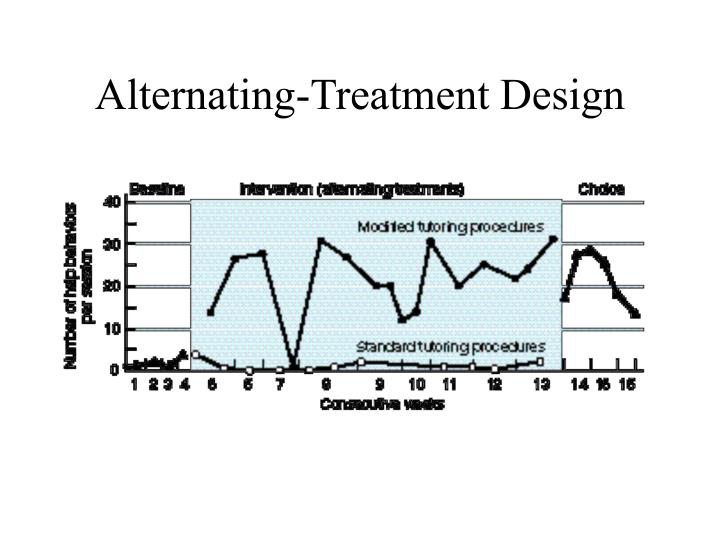Table Of Content

The subsequent comparison of prompt-fading procedures revealed that MTL prompting was more effective and efficient than LTM prompting for all three participants. Conventional approaches to single-subject data analysis rely on visual inspection (as reviewed earlier in this article). From the perspective of clinical significance, supporting a “visual inspection–only” approach is warranted because the practitioner (and, ultimately, the field of practice) is interested in identifying only those variables that lead to large, unambiguous changes in behavior.
(PDF) Statistical analysis for single case data: Draft chapter - ResearchGate
(PDF) Statistical analysis for single case data: Draft chapter.
Posted: Sun, 24 Jan 2016 01:02:07 GMT [source]
Single-Subject Experimental Design for Evidence-Based Practice
Among the outcome measures defined in the current review, some records showed significant improvement in some but not all contributing measures (Eikeseth et al., 2002; Reed et al., 2007a; Zachor et al., 2007). Others had statistically significant improvement in all contributing measures of a given outcome (Dixon et al., 2018; Howard et al., 2005; Lovaas, 1987; Novack et al., 2019; Smith et al., 2000; Zachor et al., 2007). At its core, ABA is the practice of utilizing the psychological principles of learning theory to enact change on the behaviors seen commonly in individuals diagnosed with ASD (Lovaas et al., 1974). F. Skinner’s theory of operant conditioning in the 1970s to help treat children diagnosed with ASD (or “autism” at the time) with the goal of altering their behaviors to improve their social interactions (Lovaas et al., 1973; Skinner, 1953; Smith & Eikeseth, 2011).

Analysis of Effects in SSEDs
In the third phase of the component analysis, the FCTcomponent was removed, leaving time-out and differential reinforcement of other behavior (DRO). Again, a decreasing trend in signing and an increasing trend in hand biting were observed, which were again reversed when the full treatment package was applied. There were few overlapping data points between the different criterion phases, and changes to the criterion usually resulted in immediate increases in the target behavior. These results would have been further strengthened by the inclusion of bidirectional changes, or mini-reversals, to the criterion (Kazdin, 2010). Such temporary changes in the level of the dependent measure(s) in the direction opposite from that of the treatment effect enhance experimental control because they demonstrate that the dependent variable covaries with the independent variable.
Analysis.
When more than two variables or interventions were compared, which sometimes occurred in the Comparisons of ABA Techniques and Between-Groups Comparison sections, study records were discussed and split into discrete rows by two researchers to represent simplified or single-variable comparisons in each row. As seen in Tables S2 and S3 in Appendix 3, further detail was extracted regarding the category of techniques or interventions compared and the relative effectiveness of each. As ABA is a broad intervention which includes many different methods and programs, reviews of the entire scope of the current research are uncommon. To our knowledge, a comprehensive review of the current ABA literature that spans all ABA methods and outcomes for children and youth with ASD, and that includes randomized controlled trials (RCT), clinical controlled trials (CCT), and single-case experimental design (SCED) studies, has not been completed.
Nonparametric statistical tests for single-case systematic and randomized ABAB…AB and alternating treatment ... - ScienceDirect.com
Nonparametric statistical tests for single-case systematic and randomized ABAB…AB and alternating treatment ....
Posted: Wed, 27 Dec 2017 00:58:04 GMT [source]

However, rather than having multiple baselines across participants, settings, or behaviors, the changing-criterion design uses multiple levels of the independent variable. Experimental control is demonstrated when the behavior changes repeatedly to meet the new criterion (i.e., level of the independent variable). An intervention or treatment cannot be considered evidence based following the results of a single study. The WWCH panel recommended that an intervention have a minimum of five supporting SSED studies meeting the evidence standards if the studies are to be combined into a single summary rating of the intervention's effectiveness. The panel also suggested the use of some type of effect size to quantify intervention effects within each study, thereby facilitating the computation of a single summary rating of the evidence in favor of the invention (a discussion of the advantages and disadvantages of SSEDs and effects sizes follows later).
Procedures.
The observers recorded each participant’s number of independent correct responses for each experimental session. Trial-by-trial IOA was used, where the number of trials with agreement was divided by the total number of trials and multiplied by 100. The dependent variable was the percentage of correct independent responses to one-step directions.
Prompt Topography Assessment
Specific exemplars of how SSEDs have been used in speech-language pathology research are provided throughout. Yes, Alternating Treatment Design can be used to evaluate a wide range of interventions, such as communication methods, behavior management techniques, or social skills training programs. The infrequent use of generalization seen in the Between-Groups Comparison section could be a result of the greater use of validated tools in this section of records (Cohen et al., 2006; Remington et al., 2007). The increasing prevalence of ASD in children and youth across the world has placed evidence-based interventions that treat these disabilities and disorders in high demand. ABA has been at the forefront of these interventions for decades and is recommended by many governments, including in the United States and Canada, as a well-established, scientifically proven therapy (Government of Canada, 2018; U.S. Department of Health & Human Services, 1999). Due to these prominent endorsements, existing and emerging interventions should be held to the same standard as established ABA interventions.
Availability of data and material
ABA recommendations were sometimes recorded in clinical reports as number of hours and sometimes recorded as number of sessions; thus, we examined ABA dose as the overall percentage of hours or sessions prescribed that were actually received. We considered a full ABA dose to be receipt of at least 80% of prescribed ABA hours or sessions.18 Service history data were collected from parents and/or caregivers during the baseline assessment conducted by ABA providers. We also included demographic variables from the Autism Registry and progress reports where there may be an influence of family or community context, developmental, or structural inequities on group differences. These included patient age (years), gender, race/ethnicity, primary language spoken (recorded into English or Other), and parent marital/partnership status (married or living with a partner versus single, divorced, or widowed parents). Race/ethnicity categories were White, Hispanic, and Other; the ‘other’ category included Black, Asian American/Pacific Islander, and Native American Indian/Alaskan Native participants because the groups were too small for individual analysis. This study replicated Seaver and Bourret (2014)’s approach to identifying effective prompt topographies prior to comparing prompt hierarchies and extended the work by providing additional support with younger populations and an alternative procedure for conducting the prompt topography assessment.
More research is needed to investigate whether these two types of prompting assessments are equally effective at identifying optimal procedures for participants; however, the outcomes of these two studies provide support for the development and use of such assessments in clinical practice with individuals with ASD. While Seaver and Bourret examined the use of extensive assessments on the same topography of a behavior chain (i.e., making Lego© patterns), the current study employed a briefer analysis of antecedent variables. Specifically, in the current study, the prompt topography assessment consisted of assessing responding to different antecedent stimuli (e.g., gestural, physical), without fading those prompts or conducting tests of generality. In clinical settings, the development and implementation of such assessments may help maximize the efficiency of training in the long run. For example, identifying effective and efficient prompt-fading procedure and using those procedures consistently across skills and domains might result in acquiring more skills as compared to making procedural decisions in the absence of such data.
Studies with adults using ABA principles, though fewer in number, show similar benefits. They have helped many kinds of learners gain different skills – from healthier lifestyles to learning a new language. Therapists have used ABA to help children with autism and related developmental disorders since the 1960s. This study of service delivery and patient outcomes after implementation of California’s autism mandate found that approximately 66% of children referred for ABA stay in services for 12 months and 46% stay in services for 24 months, with relatively low rates of full ABA dosing.
A description of the criteria developed by the panel as well as their application to evidence-based practice in CSD follows. In Panel A of Figure 2, no change is observed until the third session of the intervention phase. This latency brings into question the assumption that the manipulation of the independent variable is responsible for the observed changes in the dependent variable. It is possible that the observed change may be more appropriately attributed to some factor outside the control of the experimenter. To rule out the plausibility of an extraneous variable, the experimental effect must be replicated, thereby showing that although there may be a delay, changes in the dependent variable reliably occur following changes to the independent variable. This type of replication (within study) is a primary characteristic of SSEDs and is the primary basis for internally valid inferences.
There is an urgent need to reconcile these differences, develop mutual understanding between these communities, work together on research focused on promoting implementation, and to influence policy. One potential additional advantage to incorporating randomization into an SSED is that the data series can be analyzed using randomization tests (Bulte & Onghena, 2008; Edgington, 1996; Todman & Dugard, 2001) that leverage the ease and availability of computer-based resampling for likelihood estimation. Exact p values are generated, and the tests appear to be straightforward ways to supplement the visual analysis of single-subject data. It should be noted, however, that randomization tests in and of themselves do not necessarily address the problem of autocorrelation. SSED studies provide a flexible alternative to traditional group designs in the development and identification of evidence-based practice in the field of communication sciences and disorders.

No comments:
Post a Comment